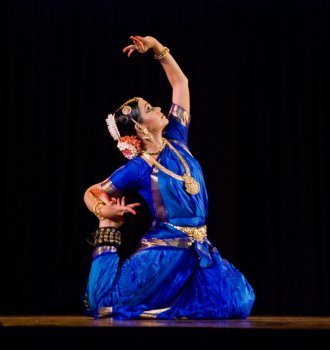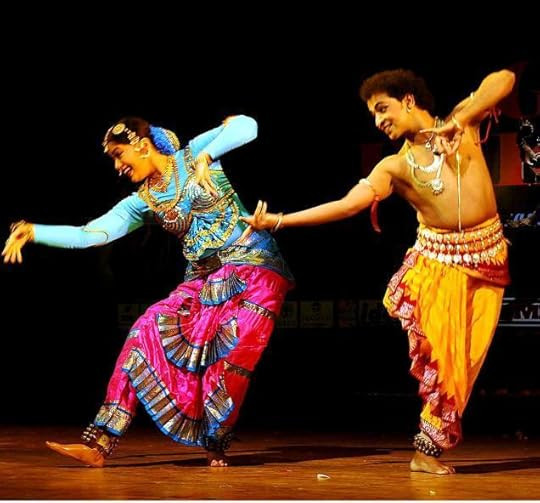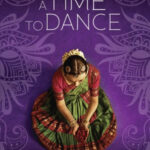“A Time to Dance” by Padma Venkatraman is a compelling novel exploring dance, identity, and resilience, offering a profound experience for readers and dancers alike. At ten-dance.com, we delve into the story’s essence, examining its themes and characters to illuminate why this book resonates deeply within the dance community and beyond, providing insights and fostering a deeper appreciation for the art of movement, cultural expression, and the human spirit. Discover how dance transcends physical limitations and embodies cultural richness, inspiring everyone to explore the world of dance.
1. What is “A Time to Dance” by Padma Venkatraman About?
“A Time to Dance” by Padma Venkatraman is a powerful young adult novel that tells the story of Veda, a talented Bharatanatyam dancer whose life is irrevocably changed after an accident results in the amputation of her leg. The novel explores Veda’s journey of physical and emotional recovery, her struggle to redefine her identity, and her eventual return to dance through sheer determination and the support of her family and community.
The narrative beautifully weaves together themes of resilience, cultural heritage, and the transformative power of dance. Venkatraman’s use of free-verse poetry gives the story an intimate and emotionally resonant quality, allowing readers to deeply connect with Veda’s experiences. “A Time to Dance” celebrates the human spirit and the ability to find strength and beauty even in the face of profound adversity, making it a moving and inspirational read. At ten-dance.com, you will find the inspiration and resources you need to begin or continue your dance journey.
2. Who is the Target Audience for “A Time to Dance”?
The target audience for “A Time to Dance” is broad, encompassing young adults, dance enthusiasts, and readers interested in stories of resilience and cultural exploration.
- Young Adults (18-35): The book appeals to young adults due to its engaging narrative, relatable protagonist, and exploration of themes such as identity, self-discovery, and overcoming challenges. The story of Veda’s journey resonates with readers navigating their own paths in life.
- Dance Students (18-55): Those with an interest in dance, particularly Bharatanatyam, find the novel captivating due to its authentic portrayal of the dance form, its cultural significance, and the challenges faced by dancers. It provides insight into the dedication and passion required to pursue dance professionally.
- Readers Interested in Cultural and Diverse Stories (18-55): “A Time to Dance” offers a window into Indian culture and the art of Bharatanatyam, making it appealing to readers interested in diverse cultural experiences and stories that celebrate cultural heritage.
- Individuals Seeking Inspirational Stories (18-55): The book’s themes of resilience, determination, and overcoming adversity resonate with readers seeking inspiration and motivation. Veda’s journey is a testament to the power of the human spirit.
- Educators and Librarians: “A Time to Dance” is often included in school and library collections due to its literary merit, cultural relevance, and positive messages. It serves as a valuable resource for discussions about identity, culture, and perseverance.
3. What are the Key Themes Explored in “A Time to Dance”?
“A Time to Dance” explores several profound themes, each contributing to the novel’s depth and emotional resonance.
- Resilience: Veda’s journey after losing her leg is a testament to her resilience. The novel portrays her struggle to adapt to her new reality, both physically and emotionally, and her determination to reclaim her identity as a dancer.
- Identity: The novel delves into the theme of identity, particularly how it is shaped by personal passions, cultural heritage, and physical abilities. Veda’s accident forces her to redefine herself and discover new facets of her identity.
- Cultural Heritage: Bharatanatyam, a classical Indian dance form, is central to the story. The novel explores the cultural significance of this art form and its role in Veda’s life, connecting her to her heritage and providing a source of strength and inspiration.
- The Transformative Power of Dance: Dance serves as a means of expression, healing, and empowerment for Veda. It allows her to connect with her inner self, express her emotions, and find joy and purpose in life, even after her accident.
- Community and Support: The support Veda receives from her family, friends, and community plays a crucial role in her recovery and return to dance. The novel highlights the importance of human connection and the power of encouragement in overcoming adversity.
- Overcoming Adversity: The narrative emphasizes the importance of perseverance, hope, and maintaining a positive attitude in the face of challenges. Veda’s journey demonstrates that with determination and support, it is possible to overcome even the most daunting obstacles.
- Self-Discovery: Through her experiences, Veda learns valuable lessons about herself, her capabilities, and her passions. Her journey is one of self-discovery, leading her to a deeper understanding of who she is and what truly matters to her.
 Veda practicing Bharatanatyam
Veda practicing Bharatanatyam
4. What Makes Veda a Relatable Character?
Veda is a highly relatable character because she embodies universal struggles and emotions, making her journey resonate with readers from diverse backgrounds.
- Passion and Dedication: Veda’s passion for Bharatanatyam is something many readers can relate to, regardless of their specific interests. Her dedication to her art and her willingness to work hard to achieve her goals are admirable qualities.
- Challenges and Setbacks: Veda faces significant challenges, including rivalry, familial expectations, and the life-altering accident that results in the amputation of her leg. Her struggles are realistic and reflect the kinds of obstacles that many people encounter in their lives.
- Emotional Vulnerability: Veda experiences a range of emotions, including joy, frustration, anger, and sadness. Her emotional vulnerability makes her feel authentic and allows readers to empathize with her experiences.
- Self-Doubt and Insecurity: Like many young adults, Veda grapples with self-doubt and insecurity, particularly after her accident. Her journey to overcome these feelings and regain her confidence is inspiring and relatable.
- Growth and Transformation: Veda undergoes significant growth and transformation throughout the novel. Her ability to learn from her experiences, adapt to change, and emerge stronger makes her a compelling and relatable character.
- Cultural Connection: Veda’s connection to her cultural heritage through Bharatanatyam is a source of strength and identity. This connection resonates with readers who value their own cultural backgrounds and traditions.
5. How Does Venkatraman Use Free-Verse Poetry to Enhance the Story?
Padma Venkatraman’s use of free-verse poetry significantly enhances the emotional depth and narrative impact of “A Time to Dance.”
- Emotional Intimacy: The free-verse format allows for a more direct and intimate exploration of Veda’s thoughts and feelings. The concise, evocative language captures the nuances of her emotional state with great clarity.
- Rhythmic Flow: The rhythmic quality of the poetry mirrors the movements of dance, creating a sense of fluidity and grace that reflects Veda’s passion for Bharatanatyam. This enhances the reader’s immersion in the story.
- Emphasis on Key Moments: Venkatraman uses line breaks and stanza breaks to emphasize key moments and emotional turning points in the story. This technique heightens the dramatic impact and allows readers to pause and reflect on significant events.
- Accessibility: The accessible language and short, digestible verses make the story engaging for young adult readers. The free-verse format breaks down barriers and allows readers to connect with the story on a personal level.
- Creative Expression: The poetry format encourages creative expression and experimentation with language. Venkatraman uses vivid imagery and metaphors to paint a rich and evocative picture of Veda’s world.
- Emotional Resonance: The combination of poetry and prose creates a unique emotional resonance that lingers with readers long after they finish the book. The story’s themes of resilience, identity, and cultural heritage are amplified through the poetic form.
6. What Role Does Bharatanatyam Play in Veda’s Life?
Bharatanatyam plays a central and multifaceted role in Veda’s life, shaping her identity, providing a source of strength, and serving as a means of expression and healing.
- Identity and Self-Expression: Bharatanatyam is deeply intertwined with Veda’s sense of self. It is not just a hobby or a skill; it is an integral part of who she is. Dance allows her to express her emotions, thoughts, and experiences in a way that words cannot.
- Cultural Connection: As a classical Indian dance form, Bharatanatyam connects Veda to her cultural heritage. It is a link to her ancestors, her traditions, and her community. This connection provides her with a sense of belonging and cultural pride.
- Discipline and Focus: The rigorous training required for Bharatanatyam instills in Veda a sense of discipline, focus, and perseverance. These qualities serve her well both on and off the dance floor, helping her to overcome challenges and achieve her goals.
- Healing and Recovery: After her accident, Bharatanatyam becomes a source of healing and recovery for Veda. The process of relearning to dance with a prosthetic leg is physically and emotionally challenging, but it allows her to reclaim her identity as a dancer and find joy and purpose in life.
- Community and Support: Veda’s involvement in Bharatanatyam connects her with a supportive community of dancers, teachers, and mentors. These relationships provide her with encouragement, guidance, and a sense of belonging.
- Spiritual Connection: Bharatanatyam is often associated with spirituality and devotion. For Veda, dance is a way to connect with something larger than herself, to express her gratitude and reverence, and to find inner peace and harmony.
7. How Does the Novel Address the Challenges Faced by Differently Abled Individuals?
“A Time to Dance” sensitively and realistically addresses the challenges faced by differently abled individuals, particularly through Veda’s experiences after her accident.
- Physical Challenges: The novel realistically portrays the physical challenges that Veda faces as an amputee. It describes the difficulties of navigating daily life with a prosthetic leg, the pain and discomfort she experiences, and the physical therapy she undergoes to regain her strength and mobility.
- Emotional Challenges: Veda experiences a range of emotions, including grief, anger, frustration, and self-doubt. The novel explores these emotions with honesty and empathy, highlighting the emotional toll that disability can take on individuals and their families.
- Social Challenges: Veda faces social challenges, such as feeling self-conscious about her appearance, dealing with stares and comments from others, and navigating social situations with a physical disability. The novel addresses these challenges with sensitivity and nuance.
- Redefining Identity: The novel explores how disability can challenge an individual’s sense of identity. Veda must redefine herself as a dancer and as a person after her accident, learning to embrace her new reality and find strength and purpose in her life.
- Overcoming Barriers: The novel emphasizes the importance of perseverance, determination, and a positive attitude in overcoming barriers and achieving goals. Veda’s journey is a testament to the power of the human spirit and the ability to thrive despite challenges.
- Promoting Inclusion: “A Time to Dance” promotes inclusion and acceptance of differently abled individuals. It challenges stereotypes and misconceptions, encouraging readers to see beyond physical differences and recognize the inherent worth and potential of every individual.
 Sudha Chandran, a Bharatanatyam dancer with a prosthetic leg
Sudha Chandran, a Bharatanatyam dancer with a prosthetic leg
8. What is the Significance of the Supporting Characters in the Story?
The supporting characters in “A Time to Dance” are essential to Veda’s journey, providing her with support, guidance, and perspective.
- Paati (Grandmother): Paati is a constant source of love and support for Veda. She embodies traditional values and provides Veda with a strong connection to her cultural heritage. Her unwavering belief in Veda’s abilities helps Veda to persevere through difficult times.
- Veda’s Mother: Veda’s relationship with her mother is complex and evolving. Initially, her mother is skeptical of Veda’s passion for dance and wants her to pursue a more practical career. However, as the story progresses, she comes to understand and support Veda’s dreams, demonstrating the importance of familial acceptance.
- Govinda: Govinda is a fellow dancer who becomes Veda’s friend and romantic interest. He shares her passion for Bharatanatyam and helps her to reconnect with the spiritual aspects of dance. Their relationship provides Veda with a sense of belonging and mutual understanding.
- Jim: Jim is the prosthetist who fits Veda with her prosthetic leg. He is kind, compassionate, and dedicated to helping Veda regain her mobility. His presence in the story highlights the importance of medical professionals in supporting individuals with disabilities.
- Kamini: Kamini is Veda’s rival in dance, and their relationship evolves throughout the story. Initially, they are competitive, but as they learn to respect each other’s talents, they form a bond of friendship and mutual support.
9. How Does the Novel Inspire Readers to Pursue Their Passions?
“A Time to Dance” is deeply inspiring, encouraging readers to pursue their passions with courage, determination, and resilience.
- Veda’s Dedication: Veda’s unwavering dedication to Bharatanatyam serves as a powerful example of what can be achieved with passion and hard work. Her commitment to her art inspires readers to pursue their own interests with similar enthusiasm.
- Overcoming Obstacles: Veda faces numerous obstacles, including rivalry, familial expectations, and a life-altering accident. Her ability to overcome these challenges and continue pursuing her dreams demonstrates the importance of perseverance and resilience.
- Finding Strength in Identity: Veda finds strength and purpose in her identity as a dancer. The novel highlights the importance of embracing one’s passions and using them as a source of strength and resilience in the face of adversity.
- The Transformative Power of Art: Dance serves as a means of expression, healing, and empowerment for Veda. The novel underscores the transformative power of art and its ability to enrich lives, provide solace, and inspire hope.
- Community Support: The support Veda receives from her family, friends, and community plays a crucial role in her journey. The novel emphasizes the importance of human connection and the power of encouragement in pursuing one’s passions.
- Embracing Individuality: Veda’s journey is one of self-discovery, leading her to a deeper understanding of who she is and what truly matters to her. The novel encourages readers to embrace their individuality, celebrate their unique talents, and pursue their dreams with authenticity and conviction.
10. What are the Five Intended Search Results for the Keyword “A Time to Dance by Padma”?
Here are five intended search results that users might be looking for when searching for “A Time To Dance By Padma”:
- Book Summary and Reviews: Users want to quickly understand the book’s plot, themes, and overall reception.
- Author Information: Readers are interested in learning about Padma Venkatraman’s background, other works, and inspirations.
- Availability and Purchasing Options: Users are looking to buy the book in various formats (e-book, paperback, audiobook) from different retailers.
- Analysis and Interpretation: Students or book club members seek in-depth analyses of the characters, themes, and literary devices used in the novel.
- Inspirational Content: Readers want to find quotes, images, or discussions related to the book that provide inspiration and motivation.
 Veda in a dance pose
Veda in a dance pose
“A Time to Dance” by Padma Venkatraman is more than just a story; it’s an experience that resonates deeply with anyone who has ever pursued a passion, faced adversity, or sought to understand their identity. Through Veda’s journey, readers are reminded of the power of resilience, the importance of cultural heritage, and the transformative nature of dance.
Ready to explore the world of dance and discover your own potential? Visit ten-dance.com today to find lessons, information, and a supportive community to help you on your journey. Whether you’re a beginner or an experienced dancer, ten-dance.com offers a wealth of resources to inspire and guide you.
Address: 60 Lincoln Center Plaza, New York, NY 10023, United States
Phone: +1 (212) 769-7000
Website: ten-dance.com
FAQ About “A Time to Dance” by Padma Venkatraman
1. Who is the author of “A Time to Dance”?
The author of “A Time to Dance” is Padma Venkatraman, an award-winning author known for her insightful and culturally rich young adult novels.
2. What is Bharatanatyam in the context of the book?
Bharatanatyam is a classical Indian dance form that is central to Veda’s identity and the story. It represents her cultural heritage, a means of expression, and a source of strength.
3. What major event changes Veda’s life in “A Time to Dance”?
Veda’s life is changed when she is involved in an accident that results in the amputation of her leg, challenging her identity as a dancer.
4. How does Veda adapt to her new circumstances after the accident?
Veda adapts by undergoing physical therapy, redefining her identity, and finding new ways to express herself through dance, with the support of her family and community.
5. What are some of the key themes explored in “A Time to Dance”?
Key themes include resilience, identity, cultural heritage, the transformative power of dance, and the importance of community and support.
6. Who are the main supporting characters in Veda’s life?
Main supporting characters include Paati (Veda’s grandmother), Veda’s mother, Govinda (a fellow dancer), Jim (the prosthetist), and Kamini (Veda’s rival).
7. How does Padma Venkatraman use free-verse poetry in the novel?
Venkatraman uses free-verse poetry to enhance the emotional depth and narrative impact of the story, allowing for a more intimate exploration of Veda’s thoughts and feelings.
8. What is the significance of dance in Veda’s journey?
Dance serves as a means of expression, healing, and empowerment for Veda, helping her to reconnect with her inner self and find joy and purpose in life after her accident.
9. How does the novel address the challenges faced by differently abled individuals?
The novel addresses physical, emotional, and social challenges faced by differently abled individuals, promoting inclusion, acceptance, and the importance of perseverance.
10. What message does “A Time to Dance” convey to its readers?
“A Time to Dance” conveys a message of hope, resilience, and the importance of pursuing one’s passions, even in the face of adversity, and embracing individuality and cultural heritage.


